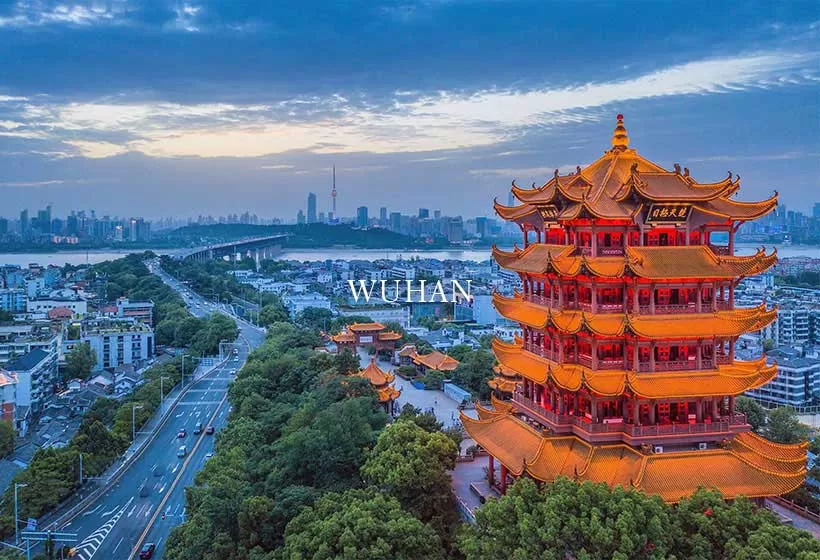Food and restaurants, what and where to eat in Hubei
Hubei, located in central China, is known as the “land of fish and rice” and the “province of a thousand lakes”. Its unique geography and climate have given rise to a rich and diverse culinary culture. Hubei cuisine, also called E cuisine, is one of China’s eight major culinary traditions. Characterized by its emphasis on aquatic products and fish dishes, it features dishes with thick, glossy sauces and flavors that are aromatic, fresh, spicy, and mellow, showcasing seven hallmark qualities of Hubei cooking: boiling, tenderness, freshness, richness, fragrance, delicacy, and ample portions. Following are the best food and restaurant in Hubei.
What to eat
Top 1: Hot Dry Noodles/热干面
Hot Dry Noodles is one of the most famous snacks in Wuhan, Hubei, and is celebrated as one of the “Five Famous Noodles of China”. It originated in the early 20th century, created and refined by street vendors Li Bao and Cai Mingwei based on traditional alkaline noodles. Because hot dry noodles are quick, convenient, and delicious, it has become the first choice for many people in Wuhan when having breakfast.
Hot dry noodles are a type of dry-mixed noodles. The noodles themselves are alkaline noodles, complemented with sesame oil, sesame paste, chopped scallions, chili oil, and other ingredients. They are smooth, chewy, golden, and glossy, with a deliciously savory taste. The soul of hot dry noodles lies in the sesame paste, whose rich, nutty aroma gives the noodles a delicate and mellow flavor. Before eating, the noodles must be mixed thoroughly while still hot, so that the sesame paste coats them like “ants crawling on a tree”. When eaten this way, they are especially fragrant and appetizing.
Top 2: Sanxian Doupi/三鲜豆皮
Sanxian Doupi is one of the main breakfast foods for Wuhan locals and a traditional folk snack with distinctive Wuhan characteristics. Square and thin in shape, golden yellow in color, and richly aromatic, it was originally a festive dish specially prepared by Wuhan people during holidays and later became a common breakfast item.
In Wuhan, the sanxian doupi from Laotongcheng has the longest history and enjoys the greatest fame, earning the title of “King of Doupi”. Tender doupi (bean skin) wraps around a filling of cooked glutinous rice, fresh pork, egg, mushrooms, dried tofu, and other ingredients, then are pan-fried to perfection. The resulting doupi is crispy on the outside and soft inside, golden and glossy, oily yet not greasy, with a taste that is both delicate and fragrant.
Top 3: Steamed Wuchang Fish/清蒸武昌鱼
In Hubei, a province known as a land of fish and rice, Wuchang fish represents the highest form of hospitality at local banquets and is famed both in China and abroad as the “first dish under the Chu sky”.
Wuchang fish, also called Megalobrama amblycephala, is named after originating from Liangzi Lake in Ezhou (ancient Wuchang). It has a small head and long body, with abundant fat and exceptionally tasty flesh. Over time, the techniques for preparing Wuchang fish have continuously improved, with steamed Wuchang fish being particularly distinctive. The finished dish maintains the fish’s whole shape, with a bright white color, glistening like jade. The fish body is garnished with red, white, and black toppings, making it elegant yet vibrant. The taste is fresh, with clear broth that preserves the original flavors, light and aromatic, accompanied by julienned ginger and sesame oil, filling the air with an enticing fragrance.
Top 4: Lotus Root Soup with Pork Ribs/排骨藕汤
Lotus Root Soup with Pork Ribs is a famous dish from Hubei, the “province of a thousand lakes”, a land of waterways, and also known as the “hometown of lotus root”. In Hubei, there is a saying: “No banquet is complete without soup.” At any feast, the highlight is always a pot of fresh, rich, and fragrant soup. Especially when made with Caidian lotus root, praised as a “treasure of the water”, this lotus root and pork rib soup is full of local character and embodies the essence of Jingchu culinary culture.
When a steaming bowl of lotus root soup with pork ribs is brought to the table, its rich aroma immediately fills the air. The broth is milky white and thick, the pork ribs tender and falling off the bone, while the lotus root is soft, glutinous, and fragrant. A sip of the hot soup delivers both the refreshing sweetness of the lotus root and the savory richness of the pork, making it an utterly enjoyable experience.
Top 5: Mianyang Three Steamed Dishes/沔阳三蒸
Mianyang Three Steamed Dishes is a traditional dish from Mianyang (today’s Xiantao) in Hubei, referring to the steamed dishes of fish, meat, and vegetables. Steaming preserves the maximum nutritional value of the ingredients, combining freshness, tenderness, succulence, and rich aroma into one, resulting in a dish of mellow flavor. Today in Xiantao, steamed dishes remains an essential part of folk banquets, with a saying that goes, “No feast is complete without the steamers”.
Mianyang Three Steamed Dishes draws on a wide variety of ingredients. For steamed fish dishes, there are steamed catfish, black carp, and eel; for steamed meat, there are steamed ribs, beef, and pearl meatballs; for steamed vegetables, there are steamed lotus root, carrot, pumpkin, and many more. The steaming methods are also countless. The meats are rich but not greasy, the fish tender without any fishy taste, and the vegetables light yet flavorful, all retaining their original taste, tender and soft.
Top 6: Jingsha Turtle/荆沙甲鱼
Jingzhou in Hubei has a city history spanning over 2,600 years. Nourished by its abundant waterways, since the Qin dynasty, locals have had the habit of eating turtle. Jingsha Turtle is a traditional famous dish from Jingzhou, made mainly with wild turtles from Dongting Lake and prepared with great care.
The essence of Jingsha Turtle lies in Jingsha doubanjiang, which is savory, slightly spicy, and carries a subtle fermented aroma. Slices of ginger and the doubanjiang are first stir-fried until fragrant, then the turtle pieces are added and sautéed to absorb the flavors. Cooking wine is poured in, along with broth and seasonings, then brought to a boil over high heat and finally simmered over low heat until the meat is tender, flavorful, and the sauce rich. Eating turtle differs from other seafood in that its meat combines the freshness of fish with the fine texture of lean meat, together with its unique gelatinous shell edges, making every bite reveal new layers of taste.
Top 7: Oil Braised Crayfish/油焖小龙虾
Every summer, the many lakes of Qianjiang in Hubei bring forth the delicious taste of crayfish. In this “hometown of crayfish”, Oil Braised Crayfish has neither a long history nor a touching story, it came into being simply because a local restaurant owner decided on a whim to create it. Since then, it has swept through Qianjiang and become a culinary symbol of the city.
Plates piled high with crayfish glow with a bright red color, glistening with oil, dotted with bits of chopped scallion that whet the appetite. Fragrant, spicy, numbing, with slightly sweet, the crayfish meat is firm and springy, and the flavorful sauce is mixed with rice or noodles, ensuring not a drop of deliciousness goes to waste.
Top 8: Wuhan Duck Neck/武汉鸭脖
Duck neck on its own has little flavor and might seem hardly worth eating. Yet after being cooked with chili peppers, star anise, and dozens of other spices, it has astonishingly become one of Wuhan people’s favorite delicacies with endless aftertaste. Its aroma is tantalizing, the taste stimulating, and the meat spicy and numbing. Unlike duck gizzards or duck liver, which can be eaten in a single bite, the joy of eating duck neck lies in savoring it slowly, gnawing and chewing to relish every layer of flavor. At the end, there’s a special satisfaction in giving a loud slurp to suck out the marrow from the bones.
Where to eat
Top 1: Cai Lin Ji Since 1928/蔡林记热干面
“Cai Lin Ji” brand was founded in 1928. Through the hard work and dedication of several generations, Cai Lin Ji grew from a single noodle shop into a diversified catering enterprise producing a variety of specialty snack products. It has become a household name in Wuhan and across the land of Jing-Chu, known as a time-honored brand with a history spanning a century.
Cai Lin Ji hot dry noodles are smooth, chewy, glossy, aromatic, and savory. Even before tasting, their inviting fragrance whets the appetite; once eaten, the rich aroma fills the air and leaves an endless aftertaste. Widely praised by locals, it is celebrated as one of the signature snacks in Wuhan.
- Recommended: hot dry noodles, Sanxian Doupi, Lotus root soup with rork ribs, Shumai, Xiangyang beef noodles
- Operating Hours: 07:00 AM – 10:00 PM
- Address: No. 6-8, Complex Building, Hubu Alley, Wuchang District, Wuhan City, Hubei
- Telephone: 18986135822
Top 2: Dazhonghua Restaurant/大中华酒楼
Dazhonghua Restaurant is a fish-specialty restaurant that enjoyed renown in Wuchang during the 1930s and 1940s, a reputation that continues to this day. After the liberation of Wuhan, the restaurant’s business grew further. Thanks to a connection with Mao Zedong’s poetry, Dazhonghua’s fame soared and spread far and wide.
Dazhonghua is a time-honored culinary brand in Wuhan with a history of 93 years. In its early days, it mainly featured Anhui cuisine. However, following the popularity of Wuchang fish, it transformed into a restaurant specializing in authentic Hubei cuisine, long standing as a leader in Wuhan’s dining scene.
- Recommended: steamed Wuchang Fish, lotus root soup with rork ribs, Mianyang three steamed dishes, red braised pork belly
- Operating Hours: 10:30 AM – 02:00 PM & 04:30 PM – 09:00 PM
- Address: No. 908, Xiongchu Avenue, Hongshan District, Wuhan City, Hubei
- Telephone: (027)87177788
Top 3: Sijimei Tangbao/四季美汤包
Sijimei is a time-honored Chinese brand established in 1922. Its name “Sijimei”, meaning “delicacies in all four seasons”, reflects the shop’s year-round offerings, spring rolls in spring, cold dishes in summer, stir-fried mitten crabs in autumn, and crisp pastries in winter, bringing it thriving business. Later, with master chefs such as Zhong Shengchu crafting Jiangsu-style xiaolong tangbao (soup-filled baozi) adapted to Wuhan tastes, the shop earned high praise from customers and came to be known as the “King of Tangbao”, gradually transforming into a specialty restaurant mainly serving xiaolong tangbao.
- Recommended: Sijimei Tangbao, hot dry noodles, Zhajiangmian, paste rice wine
- Operating Hours: 08:00 AM – 09:30 PM
- Address: No. 69-3, Minzhu Road, Wuchang District, Wuhan City, Wuhan
- Telephone: 13774652928
Top 4: Laotongcheng Restautant/老通城
Laotongcheng is the name of a large restaurant located at the intersection of Zhongshan Avenue in Hankou, famed for serving the famous local snack sanxian doupi, earning it the title “King of Doupi”. Founded in 1931, the restaurant improved upon the traditional Hubei folk snack doupi and paired it with sweet dishes to suit local tastes, gaining great popularity. Visitors from other regions and foreign guests coming to Wuhan all take delight in having the chance to taste Laotongcheng’s doupi.
- Recommended: Laotongcheng Sanxian Doupi, paste rice wine
- Operating Hours: 07:00 AM – 07:00 PM
- Address: No. 677, Zhongshan Avenue, Qiaokou District, Wuhan City, Hubei
- Telephone: 13277910668
Top 5: Yoogle Braised Crayfish/友锅卤虾
Yoogle Braised Crayfish is the pioneer of braised crayfish and a renowned crayfish establishment in Qianjiang. It uses locally sourced freshwater crayfish from Qianjiang, prepared with a unique “braising” method. The combination of numbing, spicy, fresh, and aromatic flavors is perfectly balanced, with brightly colored, enticingly spicy and savory, with a rich, fragrant broth and exceptionally layered taste.
- Recommended: oil braised crayfish, crucian, pan-fried pork baozi
- Operating Hours: 11:00 AM – 09:00 PM
- Address: No. 33, Ziyue Road, Qianjiang City, Hubei
- Telephone: (0728)6667777
GREAT FAMILY CHINA TOUR
JULY 2024 We wanted to thank Grace at China Culture tour for organizing a great tour of China. We enjoyed our Beijing - Xian-Chengdu -Guilin -Yangshuo - Shanghai trip. Our local guides Bruce in Beijing, Susan in Xian, Jane in Chengdu, Mike in Guilin and Mary in Shanghai took care of us…read more details »
Teng Han L from SINGAPORE
Ready to Create a Unique Dream Travel?


